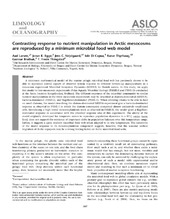| dc.contributor.author | Larsen, Aud | |
| dc.contributor.author | Egge, Jorun Karin | |
| dc.contributor.author | Nejstgaard, Jens Christian | |
| dc.contributor.author | Di Capua, Iole | |
| dc.contributor.author | Thyrhaug, Runar | |
| dc.contributor.author | Bratbak, Gunnar | |
| dc.contributor.author | Thingstad, Tron Frede | |
| dc.date.accessioned | 2016-04-05T13:33:09Z | |
| dc.date.available | 2016-04-05T13:33:09Z | |
| dc.date.issued | 2015-01-27 | |
| dc.Published | Limnology and Oceanography 2015, 60:360-374 | eng |
| dc.identifier.issn | 0024-3590 | en_US |
| dc.identifier.uri | https://hdl.handle.net/1956/11853 | |
| dc.description.abstract | A minimum mathematical model of the marine pelagic microbial food web has previously shown to be able to reproduce central aspects of observed system response to different bottom-up manipulations in a mesocosm experiment Microbial Ecosystem Dynamics (MEDEA) in Danish waters. In this study, we apply this model to two mesocosm experiments (Polar Aquatic Microbial Ecology (PAME)-I and PAME-II) conducted at the Arctic location Kongsfjorden, Svalbard. The different responses of the microbial community to similar nutrient manipulation in the three mesocosm experiments may be described as diatom-dominated (MEDEA), bacteria-dominated (PAME-I), and flagellated-dominated (PAME-II). When allowing ciliates to be able to feed on small diatoms, the model describing the diatom-dominated MEDEA experiment give a bacteria-dominated response as observed in PAME I in which the diatom community comprised almost exclusively small-sized cells. Introducing a high initial mesozooplankton stock as observed in PAME-II, the model gives a flagellate-dominated response in accordance with the observed response also of this experiment. The ability of the model originally developed for temperate waters to reproduce population dynamics in a 10°C colder Arctic fjord, does not support the existence of important shifts in population balances over this temperature range. Rather, it suggests a quite resilient microbial food web when adapted to in situ temperature. The sensitivity of the model response to its mesozooplankton component suggests, however, that the seasonal vertical migration of Arctic copepods may be a strong forcing factor on Arctic microbial food webs. | en_US |
| dc.language.iso | eng | eng |
| dc.publisher | Wiley | en_US |
| dc.rights | Attribution CC BY-NC-ND | eng |
| dc.rights.uri | http://creativecommons.org/licenses/by-nc-nd/3.0/ | eng |
| dc.title | Contrasting response to nutrient manipulation in Arctic mesocosms are reproduced by a minimum microbial food web model | en_US |
| dc.type | Peer reviewed | |
| dc.type | Journal article | |
| dc.date.updated | 2016-02-04T12:16:26Z | |
| dc.description.version | publishedVersion | en_US |
| dc.rights.holder | Copyright 2015 the authors | en_US |
| dc.identifier.doi | https://doi.org/10.1002/lno.10025 | |
| dc.identifier.cristin | 1321218 | |

